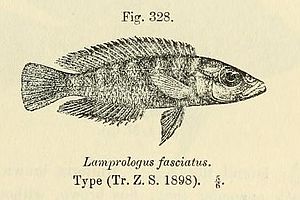Neolamprologus fasciatus
| Neolamprologus fasciatus | ||||||||||||
|---|---|---|---|---|---|---|---|---|---|---|---|---|

Drawing from the first description by George Albert Boulenger |
||||||||||||
| Systematics | ||||||||||||
|
||||||||||||
| Scientific name | ||||||||||||
| Neolamprologus fasciatus | ||||||||||||
| ( Boulenger , 1898) |
Neolamprologus fasciatus ( Syn .: Lamprologus fasciatus ) is a cichlid endemic to Lake Tanganyika . It is common in the south, rare in the north, and itis absenton the coast of Burundi .
description
Neolamprologus fasciatus becomes 14 to 15 cm long and has a cylindrical, elongated body. The basic color is sand yellow to ivory. On the sides of the body there are about nine brownish transverse ligaments, which can also be forked. Outwardly, males and females cannot be distinguished. The iris is colored turquoise blue. In adaptation to the acquisition of food in narrow crevices in the rock, the pointed mouth is narrow and the fish can “squint” their eyes forwards in order to be able to locate their prey precisely.
Way of life
Neolamprologus fasciatus lives in the shallow water of Lake Tanganyika at depths of two to five meters on the scree and rocky littoral. The fish feed mainly on small shrimp and young cichlids. They are substrate spawners who often spawn in empty snail shells on sandy grounds.
Individual evidence
- ↑ a b Pierre Brichard: The Great Book of Tanganyika Cichlids. With all the other fish on Lake Tanganyika. Bede Verlag GmbH. 1995, ISBN 978-3927997943 , page 343.
- ↑ a b Wolfgang Staeck, Horst Linke: African cichlids, cichlids from East Africa. Tetra Verlag, 1981, ISBN 3-8974-5103-4 , pages 97-98.
Web links
- Neolamprologus fasciatus on Fishbase.org (English)